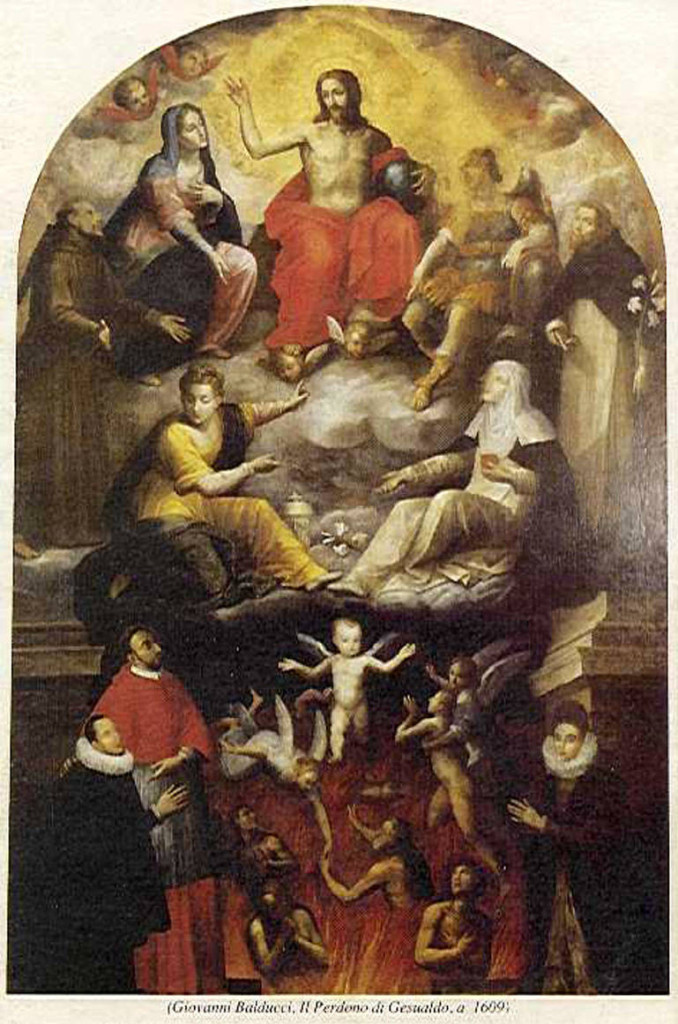Prince Don Carlo Gesualdo: Sublime Renaissance Composer or Mad Butcher?
The music and life of Gesualdo have fascinated me for years. A seriously rich and powerful nobleman who wrote music in 1600 that sounds like it was written yesterday and who murdered his wife and her lover and who went mad at the end of his life? Hollywood couldn’t dream up anything better…

Il perdono di Gesualdo (Giovanni Balducci, 1609). The composer is kneeling, at the bottom right, in front of his uncles Saint Charles Borromée, who is wearing a cardinal’s robe.
Following are some highlights from his life:
- Born in 1560, he was known as Gesualdo da Venosa, Prince of Venosa and Count of Conza. The Principality of Venosa was part of the Kingdom of Naples.
- His family was wealthy, powerful and very connected to the Vatican. His Uncle was Saint Charles Borromeo and his great uncle was Pope Pius IV.
- From an early age, he had a single-minded devotion to music and showed little interest in anything else. He played lute, harpsichord and guitar. Through private tutors and self-teaching he became a skilled musician and composer.
- In 1586 he married his first cousin, Donna Maria d’Avalos, daughter of the Marquis of Pescara. Two years later, she started a love affair with Fabrizio Carafa, Duke of Andria. She kept the affair secret from her husband for almost two years, even though it was well known to others.
- The brutal showdown happened on October 16, 1590, at the Gesualdo’s palazzo in Naples. He pretended to go away on a hunting trip. He arranged with his servants to have keys to the locks of his palace copied in wood so that he could gain entrance if it were locked. The two lovers took insufficient precaution. Gesualdo returned to the palace, caught them in flagrante delicto and murdered them both in their bed. Afterward, he left their mutilated bodies in front of the palace for all to see. Being a nobleman he was immune to prosecution, but not to revenge, so he fled to his castle at Venosa where he would be safe from any of the relatives of either his wife or her lover.
- The depositions of witnesses to the magistrates have all survived and give plenty of gory details. Gesualdo had help from his servants, who may have done most of the killing; however, Gesualdo certainly stabbed Maria multiple times, shouting as he did, “she’s not dead yet!” The Duke of Andria was found slaughtered by numerous deep sword wounds, as well as by a shot through the head. When he was found, he was dressed in women’s clothing (specifically, Maria’s night dress). His own clothing was found piled up by the bedside, unbloodied… The police report from the scene makes for shocking reading even after more than four hundred years.
- The murders got lots of publicity. Many poets wrote verses trying to capitalize on the sensation. Even though the salacious details of the murders were broadcast in print, nothing was done to arrest Gesualdo. Presumably he was viewed as too powerful.
- While in hiding in his castle, Gesualdo had an entire forest cut down that lay between the castle and the town of Venosa so that he could see if angry relatives and/or their henchmen or lawmen were approaching.
- Accounts on events after the murders differ. According to some sources, Gesualdo also murdered his second son by Maria, who was an infant, after looking into his eyes and doubting his paternity (according to a 19th-century source he “swung the infant around in his cradle until the breath left his body”); another source indicates that he murdered his father-in-law as well, after the man had come seeking revenge. Gesualdo had employed a company of men-at-arms to ward off just such an event. However, contemporary documentation from official sources for either of these alleged murders is lacking.
- In 1594 and 1595 he lived in Ferrara publishing his first book of madrigals and playing a public part in the progressive music scene of the City. He met his second wife there whom he married in 1597.
- When he returned to Venosa in 1595, he basically became a recluse. He hired his own virtuoso musicians who lived in his castle and sang his own music for him alone in his chapel. Relations with his second wife quickly turned sour and she spent most of her time with her family in Modena. One historian wag wrote: “She seems to have been a very virtuous lady…for there is no record of his having killed her.”
- Gesualdo suffered from huge depression and, one can assume, guilt and remorse. He had himself beaten daily and spent endless time on quests to buy holy relics that he thought would cure his mental illness and give him absolution. It is hard to imagine what it would have been like to be one of the musicians in his employ. It must have been an eerie and dangerous assignment.
- During this time of madness and isolation, he wrote only sacred music, including Marian motets (did he have his first wife, Maria, in mind?) and polyphony related to death and the religious services in Holy Week. His style, which had always been emotional and personally expressive became intensely more so. His Tenebrae Responses for Maundy Thursday and Holy Saturday are among the most experimental (and brilliant) of sacred Renaissance works displaying sharp dissonances and shocking chromatic juxtapositions. We will be singing parts of these two works in our concert.
- He died in isolation in 1613.
- Today, Venosa is a sleepy town east of Naples in the center of the ankle of the boot of Italy. Gesualdo is still a major, infamous legend there. After 400 years, they are quietly proud of him.
- His music lay virtually dormant for 300 years. His reputation became a small footnote for scholars about the Mad Prince or the Butcher of Venosa. In the early 20th century, modern maverick composers such as Berg, Schoenberg and Stravinsky became interested in his innovative, chromatic, radically expressive style. Stravinsky made a pilgrimage to Venosa and unearthed additional unknown works. Aldous Huxley wrote a review of his music, referring to “…psychosis working on a late medieval art form.”
- His music, like that of many Renaissance composers, really started to be performed frequently again with the early music revival of the second half of the 20th century. At first, the interest was centered on his passionate madrigals but since the late 1980s more and more attention has been paid to his final sacred masterpieces.
There are now many fine recordings of Gesualdo’s music. Also, In 1985, Werner Herzog made a movie/documentary about Gesualdo called Death for Five Voices. You can watch it on You Tube – I recommend it.
Apparently, in 1998 a jazz arranger/composer and a saxophonist from Italy released a CD called Gesualdo Splash… I can’t imagine…
Andrew Balfour




